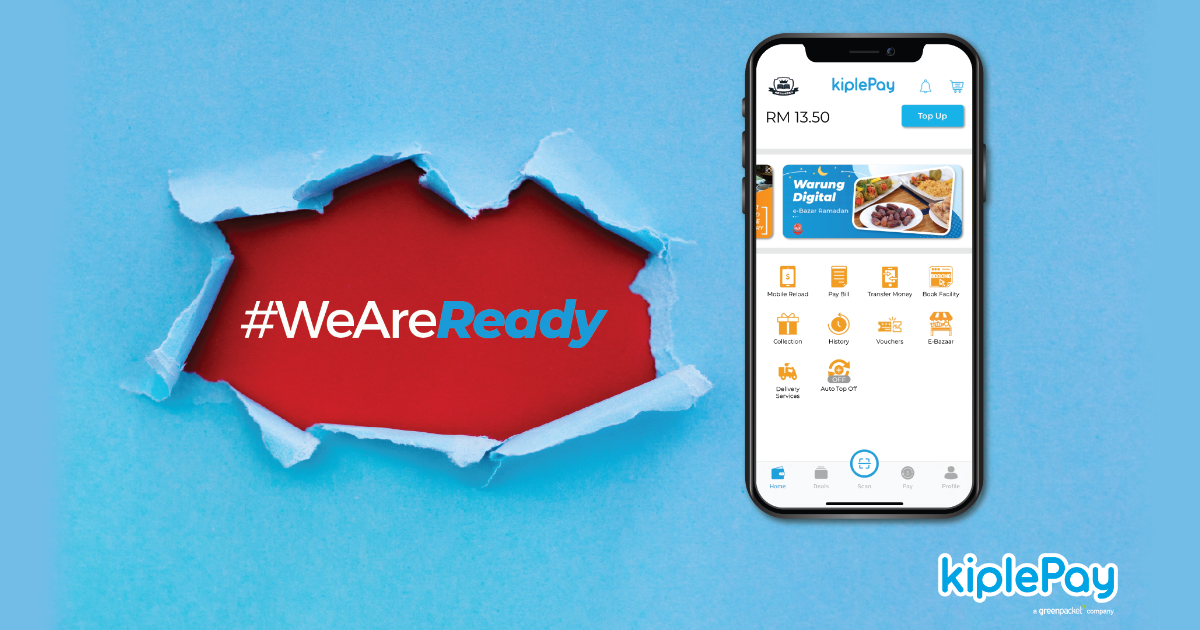
kiplePay, an e-wallet payment system under Green Packet Bhd, has introduced an array of features aimed at helping merchants adhere to the stringent standard operating procedures (SOPs) during the conditional Movement Control Order (cMCO).
kiplePay CEO Kay Tan says businesses faced a significant decline in sales since the start of the MCO in March. Although they are now allowed to operate, they have to comply with SOPs which are taking their focus away from generating enough sales to sustain their operations.
“A lot of these businesses had to let go of staff to remain afloat. This means they do not have enough human capital to adhere to the stringent SOPs, which include having all the staff and customers fill health declaration forms and ensuring social distancing in the premise,” says Tan.
By using kiplePay, business owners are able to minimise the need for their staff members to physically take orders and handle payments. Dine-in customers, for example, can order and make payments via the QR codes on the tables without having to interact with any of the staff members. Meanwhile, takeaway or self-collect customers can order and make payments in advance, only coming to pick up their orders when notified.

Aside from allowing staff members to fill in health declaration forms digitally, the kiplePay merchant app also enables business owners to limit the number of customers and enforce social distancing among its customers. “We want to help our merchants get used to the new normal. By using the app, the business owners do not have to worry about compliance and can instead focus on getting back on their feet,” says Tan.
At the start of the MCO, retail stores were not allowed to operate and most food and beverages outlets depended on deliveries to generate sales. Taking advantage of the situation, there was a noticeable spike in the number of social media sellers over the past few months, says Tan. Although these sellers have been able to gain a sizeable exposure by promoting their businesses on channels such as Facebook, Instagram and Whatapps, they are struggling with inventory and payment systems, he says.
“The process is not as seamless as it could be. After the customers decide on an order, the sellers will usually ask them to transfer their payments to a bank account. The order will only be processed after the customers send their proof of purchase, which may take some time,” says Tan.
To address this problem, kiplePay has developed 1-Click Payment, a feature which allows merchants to create a web portal with all the information pertaining their stock-keeping units (SKUs). When customers contact them to buy a specific product, the merchants can go to the portal, retrieve the link to the SKU’s payment page and send it to the customer.
Through this link, the customer is able to choose any payment alternative to complete the purchase, either by using online banking or credit and debit cards. Merchants will be notified when the payment is accepted. They can then start to prepare the orders for delivery or self-pickup by the customers.
“We are also working on integrating the portal with delivery partners so that it becomes even easier for merchants to handle the orders. When this is completed, merchants can focus on interacting with their customers and promoting their businesses on their preferred social media channels while we help with the rest. Our goal is to help small business owners boost their sales and increase operational efficiency,” says Tan.
The 1-Click Payment feature provides more confidence to buyers and sellers as the transactions are traceable and real-time, says Tan. “Another trend we see online is merchants selling their goods through Facebook Live, letting their audience bid for the best price. Usually, the buyers who win the bid will be asked to transfer the money to the seller.
KiplePay allow the ease of online transaction gateway adoption for business owners.



“In Malaysia, many of these sellers are seafood vendors. When the bids are done, they will start cutting up the produce to be delivered to the buyers. If the money is never banked in, the sellers will end up with wastage. By signing up with us, they eliminate this problem completely,” says Tan.
At the moment, the kiplePay team is working on a feature to handle inventory as well. “For example, let’s say the merchant is selling 100 pieces of ‘baju raya’. The inventory on the portal will reflect the completed purchases. When the inventory hits zero, payments will no longer be accepted. This will definitely help merchants who are selling large quantities of products,” he adds.
kiplePay is an e-money issuer licensed by Bank Negara Malaysia. Starting in 2018, kiplePay focused on offering its services to public universities with cashless ambitions. The platform works with the universities to enable payments, financing distribution (for scholarships and zakat) as well as facilities booking through a co-branded app. For example, students who wish to book a tennis field can do so and pay the booking fee through the app, eliminating the need for them to manually visit the facilities before their intended time of use.
The platform has onboarded four universities so far - Universiti Utara Malaysia, Universiti Teknikal Malaysia Melaka, Universiti Putra Malaysia and the Universiti Teknologi MARA chain, starting from the Shah Alam campus.
Beyond the universities, kiplePay offers whitelabel wallet-as-a-service (WaaS) solution to any large community wanting to organise a payment facility fully customisable to its needs. Tan says that the community can either build their own apps or co-brand with kiplePay to introduce this facility.
The features that the communities are able to enjoy through the WaaS service include enabling electronic know-your-customer management, online and in-store payments, QR payments, money transfer, voucher generation and redemption as well as loyalty and card management. The aim is to create more cashless communities in Malaysia, says Tan.
To find out more, logon here
